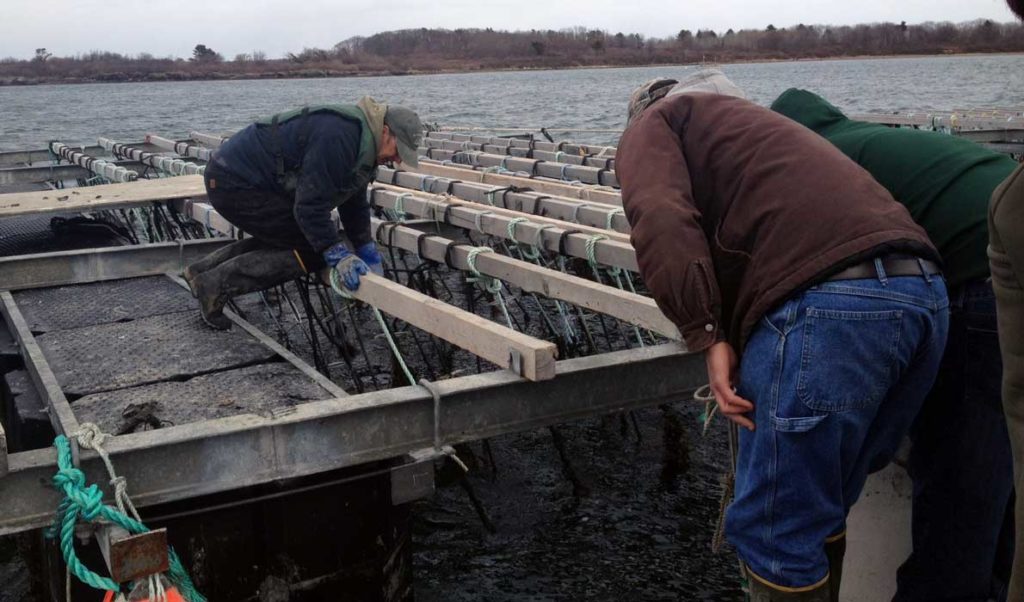As fall approaches, lobstermen are seeing 3,000-pound days with lobsters at $4-$6 per pound. Emerging Asian markets and increased competition for supply from processors are two of the many factors driving this trend. Consumers of the McLobster roll might have helped, too.
All of this good fortune deepens our economic dependence on this one species, which can be problematic. But it also provides an opportunity for Maine as a state to invest in the future of our marine economy from a position of strength. Shellfish and kelp aquaculture appear to be good choices for those investments.
The community on and around Chebeague Island certainly sees it this way.
Within the waters of this one island, you will find Oceans Approved’s kelp farm, Chebeague Island Oysters, Bangs Island Mussels, Calendar Island Mussels and Basket Island Oysters. The start-up costs for these businesses range from $50,000 to $250,000, provided the entrepreneurs already have a boat. In each case, there are significant opportunities to expand to meet growing markets. Each business is small and run independently by owners who are actively engaged in all aspects of each company.
To call this an industry would be a stretch, but they are certainly a group of businesses with the potential to become an industry. What would the industrial scale look like? Well, there will be choices.
The more dominant model in fisheries and aquaculture would be for small scale growers to establish their growing sites and then sell them to larger producers. Such a move would achieve efficiencies of scale while stabilizing quality and supply across multiple aquaculture lease sites.
We’ve witnessed this trajectory in Maine before, in the 1980s and 1990s with salmon aquaculture. Today, Cook Aquaculture owns all the salmon pens in Maine. It is one outcome, but it in no way reflects the owner-operator ethos of the Maine lobster industry.
An alternative model could mirror the Maine lobster harvester cooperative. In this example, dozens of small-scale kelp, mussel or oyster harvesters would sell their products through cooperatives that sell directly to processors (or perhaps own a processing facility). This would allow for distributed ownership and enable an industry to develop that supports job diversification at a scale that could begin to absorb any shocks to the lobster industry.
In order for either of these models to work, the entrepreneurs involved will need access to capital. During the start-up phase they need access to hundreds of thousands of dollars of “patient” capital, but as they move into value-added products that could require owning processing facilities, they will need access to tens of millions of dollars.
Chebeague Island Oyster Company provides an interesting model for dealing with the challenges of raising start-up capital. In this example, seasonal and year-round residents worked together to start the company. A local fisherman who knows the water helped establish the sites for the operation. His partners in the year-round and seasonal community worked together to round up the capital needed to launch the business and provided business management expertise along the way.
The Chebeague model also helps when dealing with the riparian concerns of waterfront landowners. Visual and noise impacts of new ocean businesses remain great concerns to waterfront landowners. On Chebeague they’ve learned that when the community outreach process for siting aquaculture is done well, people will begin to volunteer their view shed for the siting of an aquaculture operation, so long as they get to taste the products.
The work ahead is to continue to partner local capital with shellfish and seaweed aquaculture business needs. This needn’t be done through banks alone. Our coast attracts many sophisticated individuals with diverse investment portfolios. A number of them would be interested in being matched with good prospective investments that speak to the qualities of Maine that they love—a clean ocean environment that supports locally run small businesses. This matchmaking is a role the Island Institute intends to play in the years ahead.
They are not just good investments because they could generate new and additional revenues for fishermen and others who want to make their living from the sea. They are good investments because they can be done with the same concern for community economies found in the lobster industry—owner-operators, conservation-minded, cooperatively owned, and concerned about community sustainability.
After explaining this to a friend the other day, she responded that “once the guys running these aquaculture operations show up on the wharf with new trucks, these businesses will grow into and a big new Maine industry.” I suspect there is truth to this statement and that we will watch it play out in the years ahead.
Rob Snyder is president of the Island Institute, publisher of The Working Waterfront. Follow Rob on Twitter @ ProOutsider.





